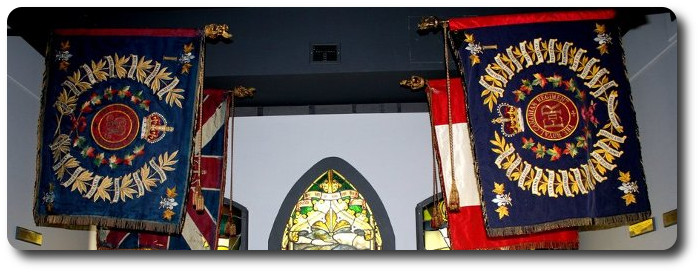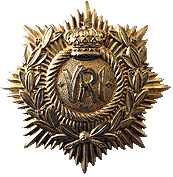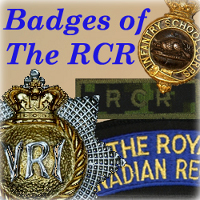
Researching The Royal Canadian Regiment
The Yukon Field Force 1898-1900

Canadian Army Journal, Vol 4, No 6, November 1950
Written Specially for the Journal by the Historical Section, Army Headquarters, Ottawa
The Canadian soldier has played a greater part in the development of modern Canada than many of his compatriots realize; and all his services have not been rendered on the battlefield. One little-known example of service of a different sort is the work of the Yukon Field Force, which helped ensure order in Canada's farthest NorthWest in the feverish days of the great gold rush.
The discovery of gold in the Klondike in August 1896 led to a rush to the Yukon, which began in 1897 and swelled to a flood in 1898. In the train of the gold-seekers came all types of humanity, both male and female, many of them of very questionable character. All told, about 42,500 people poured into the Territory.
The North-West Mounted Police-first sent into the Yukon in 1894-were reinforced, and to assist them in maintaining law and order a force of 203 volunteers from the Permanent Militia 2 was dispatched there in the spring of '98. The Yukon Field Force, authorized by order-in-council 21 March 1898, was commanded by Lt., Col. T.D.B. Evans of the Royal - Canadian Dragoons and composed as follows: -
- Staff - 5
- The Royal Canadian Dragoons - 16
- Royal Canadian Artillery - 49
- The Royal Regiment of Canadian Infantry (now The Royal Canadian Regiment) - 133
The Force, armed with Lee-Enfield (.303) magazine rifles and two Maxim guns 3 left Ottawa on 6 May and arrived at Vancouver 11 May. Three days later it embarked on the steamship Islander and proceeded to Islander, in the Alaska Panhandle, the passage taking two days. Transshipping supplies and equipment on 17 and 18 May to the stern-wheelers Strathcona and Stikine Chief, the Force proceeded on 19 May up the Stikine River to Glenora, the Stikine Chief arriving on 21 May.
The Strathcona was delayed for a few days on account of engine trouble. An advanced party of fifty skilled axemen left Glenora for the Yukon on 1 June to construct log barracks at Fort Selkirk at the junction of the Pelly and Upper Yukon rivers. Fort Selkirk, an old Hudson's Bay Company's post, was to become the Headquarters of the Force.
The main body left Glenora on 9 June for Telegraph Creek. Thence in small parties with a train of mules each carrying 200 lbs. apiece the Force travelled the Teshn Trail to Lake Teslin, reached in mid-August. Here on the shores tents were pitched and supplies were piled, the camp being named "Camp Victoria". The rations of corned-beef and biscuit (hard-tack) were augmented by fish and game. Salmon varying in weight from 10 to 15 lbs. were obtained by spearing - a bayonet affixed to a pole being the improvised spear.
From Camp Victoria to Fort Selkirk the Force travelled by water route via the Teslin and Lewes rivers which empty into the Yukon. This stage of the journey was covered by a convoy of five pilot boats and four scows. The men rowed by day and camped on shore at night. The Force left Camp Victoria on 29 August and after arduous days of heaving the scows off sand-bars and shooting dangerous rapids - particularly the swirling waters of the Five Fingers Rapids - reached Fort Selkirk on 11 September.
In compliance with a request from the Commissioner of the Yukon Territory, that a detachment of fifty of the Yukon Field Force be stationed at Dawson City, two officers and 50 other ranks, with one of the Force's two Maxim guns, proceeded there by river steamer on 1 October.
The routine duties of the troops in the Yukon consisted of mounting guards over the gold in the banks, and assisting in collecting the Government royalties. Extraneous duties included that of fire-fighting. One disastrous fire in which the troops rendered aid occurred in the fall of 1898; an account of it appears in the history of The Royal Canadian Regiment:
"One morning in mid-October, as the men of the Dawson detachment were settling into their new routine, the bugles of the main guard sounded the alarm and the troops, tumbling out into the dark of a bitterly cold dawn, saw a great glare in the sky and few that Dawson City was on fire. A carouse in the Monte Carlo theatre had resulted in an upset oil lamp, so the story later ran, and a score of buildings were blazing fiercely. For a time, despite the efforts of the Mounted Police, the Yukon Field Force detachment, and of the civilian population, the fire spread rapidly, the danger being intensified when certain of the civilian salvage crews discovered whiskey in a blazing saloon, dragged a half dozen barrels to the street, stove in the tops, and invited all so inched to drink as much as they wanted. Meanwhile the flames swept on. Dynamite was used without effect, but eventually a fire-engine, released by the Yukon Commissioner from a warehouse where it lay in bond, supplied streams of water which brought the fire under control. Blocks of the town lay in ashes by this time; the remaining blocks would also have burned but for the work the police and the troops accomplished." - Regimental History, Vol 1, pp 76.


